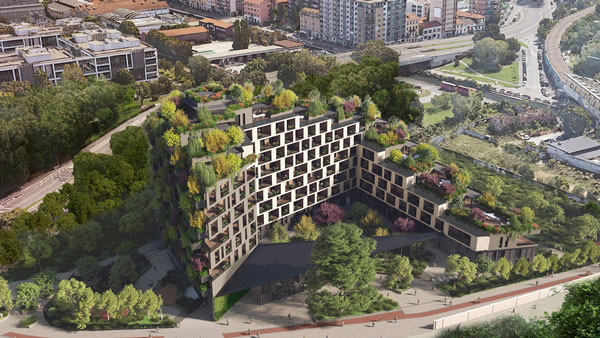Cities across most of Europe experienced higher summer temperatures in 2023 than ever seen before and it’s likely to continue.
It makes it challenging for urban life to be enjoyable let alone bearable during times of increasing global temperatures. While some solutions must come in the form of improved building operations, structures themselves, both old and new, need to adapt.
Paris, the world’s seventh most crowded city, is an example of the conflict between historic preservation and today’s climatic reality.
Public green space is hard to find in Paris. According to data from the World Cities Culture Forum, public green space represents only 9.5 per cent of Paris, versus over 45 per cent in Vienna and 68 per cent in Oslo. Even New York City has over 25 per cent green space.
As much as 80 per cent of rooftops in Paris are made of grey zinc, an estimated 110,000 properties in total. They are angular, beautiful and contribute to the overall charm of the city. In fact, Paris officials launched a campaign to have UNESCO grant the roofs a world heritage protection.
The problem is that zinc is highly heat-absorbent, contributing significantly to the heat island effect. Air temperatures in Paris exceeded 42°C in 2023.
Three architects have formed Roofscapes Studio and propose to top Paris’ sloped zinc rooftops with green spaces supported by wooden platforms that span the peaks. This could potentially lower the city’s ambient temperature by preventing the roofs from overheating while also increasing biodiversity and create flat gardens, terraces and walkways.
“Climate disruption is forcing the built environment to protect its inhabitants from increasingly extreme temperatures,” the group says. “For a city to adapt and be resilient to climate-change, it is urgent to make use of solutions that are passive, replicable and low-tech.”
A prototype is expected to be unveiled this year, with costs estimated between C$1,900 to C$2,500 m² per square metre, roughly one-fifth the purchase price of a Paris apartment.

The French Culture Ministry’s Bâtiments de France must be convinced to back away from historic protective instincts in order to create a more favourable urban living experience, something that is easier said than done.
As innovative as it sounds, this rooftop initiative would not be unique. Since 1991, Zurich, Switzerland has mandated green roofs for all flat roofs on new buildings not used as terraces. Linz, Austria and Rotterdam in the Netherlands have had similar programs for decades.
Sometimes it is easier to start initiatives with entirely new buildings. Possibilities are then almost endless, both in terms of visual appeal and lifestyle enjoyment. The Bosconavigli in Milan, Italy offers a tantalizing example of what is achievable.
Construction was completed this past November of the fifth level of this remarkable residential complex. Once completed, the project will occupy 9,000 square metres in an urban Milan district previously occupied by a decommissioned train yard.
Architect Stefano Boeri promises that the 11-level Bosconavigli will deliver reforestation, improved public spaces, and green terraces, highlighted by the planting of 170 trees representing 60 different species, plus shrubs and climbing plants.
There will be a 3500- square-metre park for condominium use and to host functions related to sports and recreational activities. More than 7,800 square metres of public area will be redeveloped in addition to a new public park along the route of the decommissioned railway.
Ninety apartments, ranging in size from 45 to over 300 square metres, will be surrounded by greenery to create large outdoor spaces, conceived as an extension from the indoors, creating true “outdoor rooms.”
While the result is certainly striking in appearance, attention has also been paid to ecological efficiency. There will be solar and photovoltaic panels on the roof, rainwater harvesting and recovery systems for the automated irrigation of all green spaces and geothermal energy production.
Occupancy of the Bosconavigli is expected to begin in 2025, with the purchase prices of units averaging C$12,000/m². Purchase prices for apartments in Milan range from C$4,000/m² to $16,000/m².
John Bleasby is a Coldwater, Ont.-based freelance writer. Send comments and Climate and Construction column ideas to editor@dailycommercialnews.com.




Recent Comments
comments for this post are closed